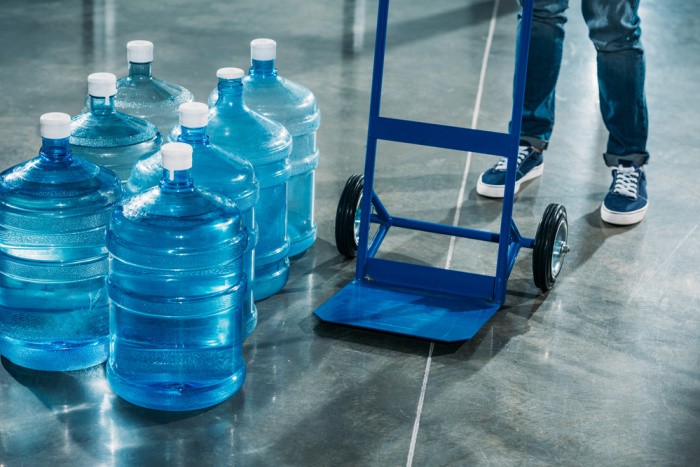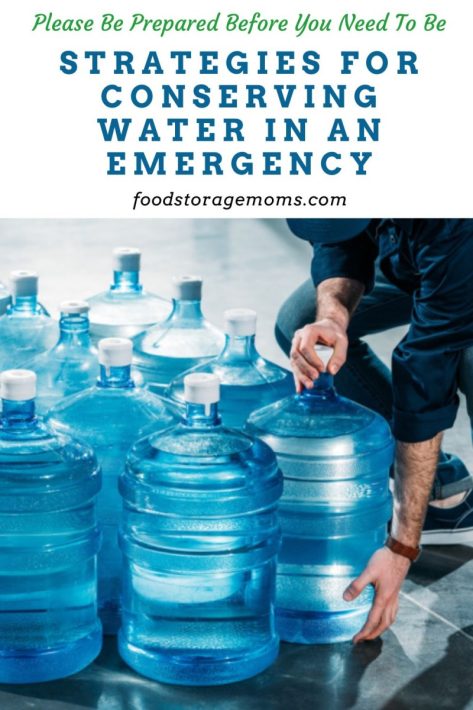
Water is an essential resource that we often take for granted. However, during emergencies such as natural disasters or other unforeseen circumstances, a reliable water supply may become scarce. In these challenging situations, it becomes crucial to conserve water. I’d like to discuss effective strategies for conserving water in an emergency.

1. Prioritize Water Usage
In emergency situations, it’s essential to prioritize water usage. Allocate water for drinking and cooking, while minimizing usage for non-essential activities such as watering plants or cleaning. When you establish priorities for the water, you can ensure that the available water resources are used most effectively.
A good example is when washing your clothes. We’ve found that with the latest clothes washers, we can use a shorter cycle and less water and still achieve clean clothes. When things get really tough, you may have to learn to flush the toilets less often.
There’s an old saying, “If it’s yellow, let it mellow; if it’s brown, flush it down.” That may seem to be an extreme measure, but it may need to be your family’s motto at some point.
There are also more efficient toilet tank flushing units that use a liter of water rather than a gallon or more. Next time you replace your toilet, consider your options.
2. Store Water in Advance
One of the most effective ways to prepare for emergency situations is by storing an adequate supply of water in advance. The recommended amount is one gallon per person per day for at least three days.
Store water in clean, airtight containers away from direct sunlight to prevent bacterial growth. Remember to regularly rotate and replace stored water to maintain its freshness. Water Storage: How Much Do You Really Need?
I’ve been recommending to my readers for a long time that they consume four gallons of water per person per day. We not only need to stay properly hydrated, but also have access to water for cooking, doing minimal laundry, and performing limited personal hygiene tasks.
When it comes to hydration, consider keeping a larger container of water in the refrigerator for drinking purposes rather than running the kitchen tap and waiting for the water to get cold enough to drink.
3. Limit Non-Essential Water Usage
During an emergency, it’s crucial to minimize non-essential water usage. Take shorter showers and turn off the faucets in your sink or bathroom wash bowl while brushing your teeth or shaving. Use kitchen-efficient appliances and fixtures to reduce water consumption. Repair any leaks and slow drips promptly to prevent unnecessary water wastage. How to Prepare for a Drought
Faucets that have aerators installed tend to use less water. Also, when available water is a concern, consider throwing more items in the trash rather than using your garbage disposal and related water to dispose of them.
We all like clean cars, but we’ll need to cut back on the frequency of those driveway-based car washes. We can also use a broom to clear debris from sidewalks, patios, porches, or driveways, rather than using a hose.
When washing cars at home, don’t leave the hose running full-time. Have a hose with an effective shut-off nozzle so the water is only running when actually needed to rinse off the dirt or soap suds. Be sure to use less water than you would at a local commercial car wash.
4. Reuse Water
In emergency situations, every drop counts. Consider reusing water whenever possible. For example, collect and reuse water from washing dishes, laundry, or bathing to flush toilets or water-specific plants. Graywater systems can be employed to treat and reuse water for various purposes, reducing the strain on existing water supplies. Creative Water Storage Solutions for Emergencies
When it comes to keeping your garden thriving, consider various irrigation systems, such as drip irrigation. Many communities are suggesting zero-scape landscaping where more small rocks take the place of lawns and flower garden beds.
If you feel strongly that you need the green stuff to stay, water less often or for shorter periods. Additionally, consider watering sections with sprinkler systems twice for shorter periods, allowing the water to soak in, which reduces overall water usage since there is less runoff.
You are also wise to use mulch in your gardens to help maintain a higher level of soil moisture. Using food waste materials in your compost pile can help reduce kitchen disposal and also minimize garden chemical usage.
5. Harvest Rainwater
Rainwater harvesting is an excellent method to supplement your water supply during emergencies. Set up rain barrels or collection systems to capture rainwater from roofs and gutters. This harvested water can be used for various non-potable purposes such as gardening or cleaning. How to Use Rainwater at Home
6. Efficient Cooking and Cleaning
During emergencies, efficient cooking and cleaning techniques can significantly reduce water usage. Opt for one-pot meals or use a pressure cooker to minimize water consumption during cooking.
When washing dishes, fill a basin with clean, clear water for rinsing instead of running the tap continuously. Use biodegradable and eco-friendly cleaning products to minimize environmental impact. 25 Smart Ways To Save Money Cooking
It has been shown that modern dishwashers actually use less water than most families use when washing dishes by hand. Conduct research to discover the most effective way to utilize your dishwasher’s features.
7. Hygiene Practices
Maintaining personal hygiene is crucial, even in emergency situations. However, it’s essential to conserve water while practicing good hygiene. Consider using wet wipes or hand sanitizers when water is limited.
When bathing, use a damp cloth or sponge bath instead of a full shower. These small adjustments can lead to substantial water savings. You may consider washing your hair less often, as it requires a significant amount of water to wash and rinse.
8. Community Cooperation
During emergencies, communities can come together to maximize water conservation efforts. Collaborate with neighbors to share resources, such as water storage containers or rainwater harvesting systems. Implement community-wide water-saving initiatives, such as group laundry or communal bathing facilities, to optimize water usage.
What You Need In A Community To Survive: Share these water conservation tips with your neighbors and extended family members, since many may be unfamiliar with the steps that should be taken.
Why is conserving water in an emergency important?
Water is a vital resource for survival, and during an emergency situation, such as a natural disaster or water shortage, the availability of clean water may be limited. Conserving water helps ensure that everyone has access to the necessary amount for drinking, cooking, and sanitation purposes.
How much water should I have stored for emergencies?
It is recommended to have at least one gallon of water per person per day for a minimum of three days. This includes water for drinking, cooking, and hygiene purposes. It’s also essential to store additional water for pets and any medical needs.
Are there any alternative sources of water during an emergency?
Yes, there are alternative sources of water during an emergency. These can include rainwater, water from natural bodies like lakes or rivers (if deemed safe), and melted ice cubes from the freezer. However, it is crucial to purify or treat these sources before using them for drinking or cooking.
How long can stored water be kept before it needs to be replaced?
Stored water should be replaced every six months for optimal freshness and quality. Mark your containers with the date of storage to keep track of when they need to be rotated. I recommend a product called Water Preserver, which, when used as directed, can keep your stored water safe for up to five years.
How can I conserve water during an emergency?
- Limit shower time and use a bucket to collect water while it warms up.
- Fix any leaks immediately.
- Only run the dishwasher or washing machine with full loads.
- Use a broom instead of a hose to clean outdoor areas.
- Collect rainwater in containers for non-potable uses, such as flushing toilets or watering plants.
- Reuse water whenever possible, such as using leftover cooking water for plants.
More Tips
- How To Store Water: Pros and Cons
- Water: Do You Have Enough Stored?
- Creative Water Storage Solutions for Emergencies
Final Word
Conserving water in an emergency is a critical aspect of disaster preparedness and response. Feel free to use the strategies mentioned above to help determine the proper use of limited water resources. If you have additional ideas I can share with my readers, please add them in the comments section below. May God Bless this World, Linda
Copyright Images: Water Bottles With Hand Truck Depositphotos_184996666_S by IgorVetushko, Water Bottles Being Delivered Depositphotos_184997244_S by IgorVetushko
The post Strategies for Conserving Water in an Emergency appeared first on Food Storage Moms.
from Food Storage Moms
No comments:
Post a Comment